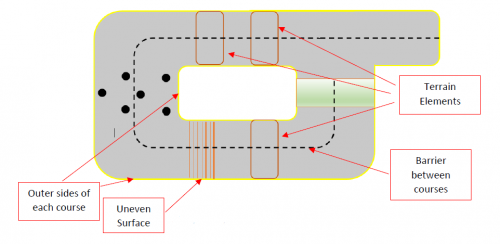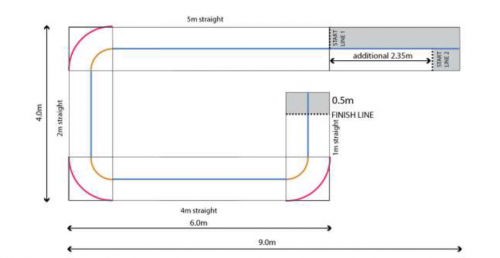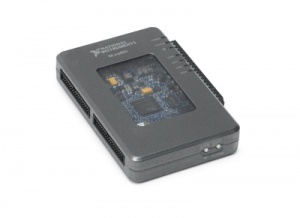Difference between revisions of "Projects:2018s1-122 NI Autonomous Robotics Competition"
| Line 13: | Line 13: | ||
Michael Prendergast | Michael Prendergast | ||
| − | == Project | + | == Project Introduction == |
Each year, National Instruments (NI) sponsors a competition to showcase the robotics capabilities of students by | Each year, National Instruments (NI) sponsors a competition to showcase the robotics capabilities of students by | ||
building autonomous robots using one of their reconfigurable processor and FPGA products. In 2018, the competition focuses | building autonomous robots using one of their reconfigurable processor and FPGA products. In 2018, the competition focuses | ||
on the theme 'Fast Track to the Future' where robots must perform various tasks on a track that incorporates various hazardous terrain, and unforeseen obstacles to be avoided autonomously. | on the theme 'Fast Track to the Future' where robots must perform various tasks on a track that incorporates various hazardous terrain, and unforeseen obstacles to be avoided autonomously. | ||
| − | This project | + | This project investigated the use of the NI MyRIO-1900 platform to achieve autonomous localisation, path planning, environmental awareness, and autonomous decision making. The live final took place in September where university teams across Australia, New Zealand, and Asia competed against each other for the grand prize. |
[[File:Map.PNG|500px|right|Competition Track]] | [[File:Map.PNG|500px|right|Competition Track]] | ||
| Line 36: | Line 36: | ||
MyRIO processor and FPGA were programmed using LabVIEW 2017, a graphical programming environment. Additional LabVIEW modules were used to process the received sensor information, such as the 'Vision Development Module' and 'Control Design and Simulation Module'. | MyRIO processor and FPGA were programmed using LabVIEW 2017, a graphical programming environment. Additional LabVIEW modules were used to process the received sensor information, such as the 'Vision Development Module' and 'Control Design and Simulation Module'. | ||
| − | == | + | == Environment Sensors == |
| − | The robot required a variety of sensors so that it | + | The robot required a variety of sensors so that it could "see" track, obstacles, boundaries and the surrounding environment. Various sensors were required so the robot could calculate its position and the locations of surrounding elements. |
The sensors used: | The sensors used: | ||
* Image sensor: Logitech C922 webcam | * Image sensor: Logitech C922 webcam | ||
| − | * Range sensors: ultrasonic & VL53LOX time of flight sensors | + | * Range sensors: ultrasonic & Lidar (VL53LOX time of flight sensors) |
* Motor rotation sensors: motor encoders package | * Motor rotation sensors: motor encoders package | ||
=== Image Sensor === | === Image Sensor === | ||
| − | A | + | A Logitech C922 was used for image or video acquisition. |
| − | + | [[File:Webcamc922.png|200px|left|NI MyRIO - 1900]] | |
| + | <!-- Replace with Logitech webcam images--> | ||
| − | |||
| − | |||
==== RGB Image Processing ==== | ==== RGB Image Processing ==== | ||
| − | The | + | The team decided to use the colour images for the following purposes: |
| − | *Identify boundaries on the floor that are marked with 50mm wide coloured tape | + | *Identify boundaries on the floor that are marked with 50mm and 75mm wide coloured tape |
*Identify wall boundaries | *Identify wall boundaries | ||
| − | Such processing will be taxing on the processor. Fortunately the myRIO contains an FPGA that | + | Such processing will be taxing on the processor. Fortunately the myRIO contains an FPGA that could used. |
| − | The competition track boundaries | + | The competition track boundaries were marked on the floor with 75mm wide yello tape. The RGB images were processed to extract useful information. |
| − | Before any image processing was attempted on the myRIO, the pipeline was determined using Matlab and its processing toolbox. | + | Before any image processing was attempted on the myRIO, the pipeline was determined using Matlab and its image processing toolbox. |
==== Determining Image Processing Pipeline in Matlab ==== | ==== Determining Image Processing Pipeline in Matlab ==== | ||
Revision as of 19:12, 17 October 2018
Contents
Supervisors
Dr Hong Gunn Chew
Dr Braden Phillips
Honours Students
Alexey Havrilenko
Bradley Thompson
Joseph Lawrie
Michael Prendergast
Project Introduction
Each year, National Instruments (NI) sponsors a competition to showcase the robotics capabilities of students by building autonomous robots using one of their reconfigurable processor and FPGA products. In 2018, the competition focuses on the theme 'Fast Track to the Future' where robots must perform various tasks on a track that incorporates various hazardous terrain, and unforeseen obstacles to be avoided autonomously. This project investigated the use of the NI MyRIO-1900 platform to achieve autonomous localisation, path planning, environmental awareness, and autonomous decision making. The live final took place in September where university teams across Australia, New Zealand, and Asia competed against each other for the grand prize.
Processing Platform
MyRIO - 1900 containing a dual core ARM processor and Xilinx Zynq FPGA.
Programming Environment
MyRIO processor and FPGA were programmed using LabVIEW 2017, a graphical programming environment. Additional LabVIEW modules were used to process the received sensor information, such as the 'Vision Development Module' and 'Control Design and Simulation Module'.
Environment Sensors
The robot required a variety of sensors so that it could "see" track, obstacles, boundaries and the surrounding environment. Various sensors were required so the robot could calculate its position and the locations of surrounding elements.
The sensors used:
- Image sensor: Logitech C922 webcam
- Range sensors: ultrasonic & Lidar (VL53LOX time of flight sensors)
- Motor rotation sensors: motor encoders package
Image Sensor
A Logitech C922 was used for image or video acquisition.
RGB Image Processing
The team decided to use the colour images for the following purposes:
- Identify boundaries on the floor that are marked with 50mm and 75mm wide coloured tape
- Identify wall boundaries
Such processing will be taxing on the processor. Fortunately the myRIO contains an FPGA that could used.
The competition track boundaries were marked on the floor with 75mm wide yello tape. The RGB images were processed to extract useful information. Before any image processing was attempted on the myRIO, the pipeline was determined using Matlab and its image processing toolbox.
Determining Image Processing Pipeline in Matlab
An overview of the pipeline is as follows:
- Import/read captured RGB image
- Convert RGB (Red-Green-Blue) to HSV (Hue-Saturation-Value)
- The HSV representation of images allows us to easliy: isolate particular colours (Hue range), select colour intensity (Saturation range), and select brightness (Value range)
- Produce mask around desired colour
- Erode mask to reduce noise regions to nothing
- Dilate mask to return mask to original size
- Isolate edges of mask
- Calculate equations of the lines that run through the edges
The produced line equations can be converted to obstacle locations referenced to the robot. Path planning can make decisions based on locations and the robot can avoid them just as it would avoid obstacles.



